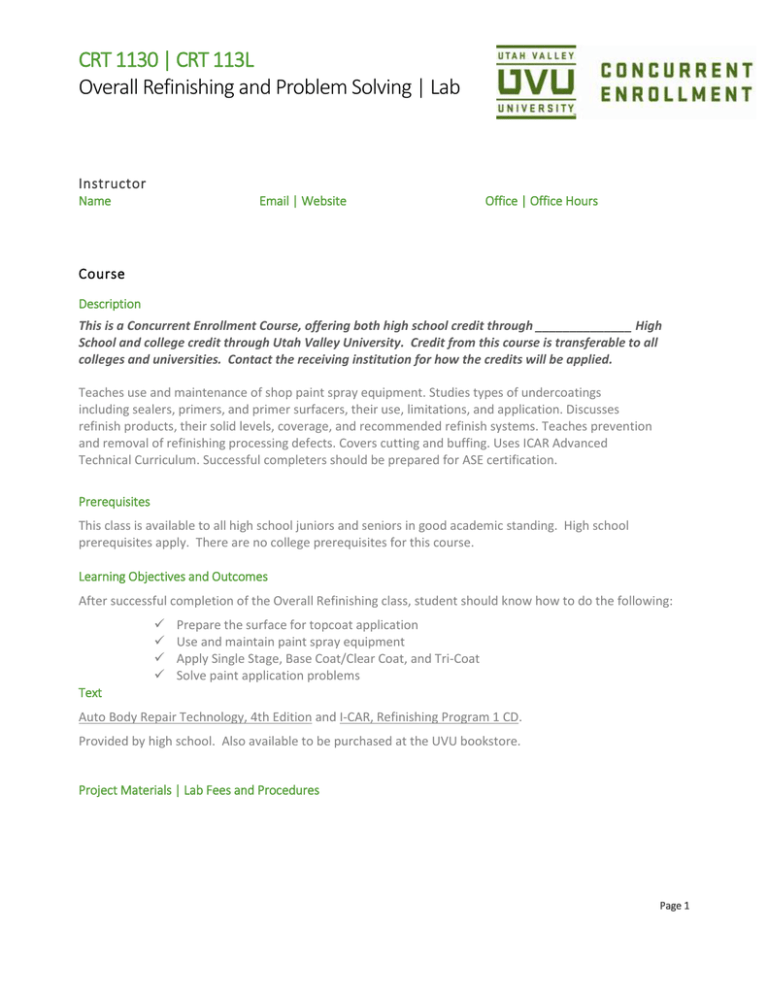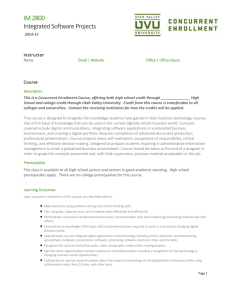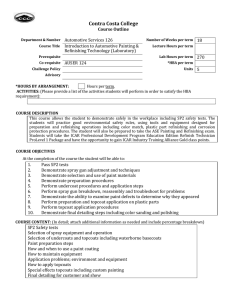CRT 1130 Overall Refinish Prob Solving CRT 113L Overall Refinish Prob Solving
advertisement

CRT 1130 | CRT 113L Overall Refinishing and Problem Solving | Lab Instructor Name Email | Website Office | Office Hours Course Description This is a Concurrent Enrollment Course, offering both high school credit through ______________ High School and college credit through Utah Valley University. Credit from this course is transferable to all colleges and universities. Contact the receiving institution for how the credits will be applied. Teaches use and maintenance of shop paint spray equipment. Studies types of undercoatings including sealers, primers, and primer surfacers, their use, limitations, and application. Discusses refinish products, their solid levels, coverage, and recommended refinish systems. Teaches prevention and removal of refinishing processing defects. Covers cutting and buffing. Uses ICAR Advanced Technical Curriculum. Successful completers should be prepared for ASE certification. Prerequisites This class is available to all high school juniors and seniors in good academic standing. High school prerequisites apply. There are no college prerequisites for this course. Learning Objectives and Outcomes After successful completion of the Overall Refinishing class, student should know how to do the following: Prepare the surface for topcoat application Use and maintain paint spray equipment Apply Single Stage, Base Coat/Clear Coat, and Tri-Coat Solve paint application problems Text Auto Body Repair Technology, 4th Edition and I-CAR, Refinishing Program 1 CD. Provided by high school. Also available to be purchased at the UVU bookstore. Project Materials | Lab Fees and Procedures Page 1 Department Policies Attendance and Participation Regular attendance is necessary for the successful completion of this course. Tardies and absences are missed opportunities to earn points towards your grade. You are expected to be in the lab each day, prepared to work. Safety Safety is a must. Not following correct safety procedures can endanger yourself and all others in the shop. We will discuss proper safety practices and procedures before any work can begin in the shop. Not following correct safety procedures will result in a loss of points. Serious deliberate safety violations will result in the student’s removal from the program. Commentary Thinking ahead to what tools and materials are required for assignments and projects is important for your overall productivity. Not having the required tools to work on assignments will result in a loss of points (See the required 1st year tool list). The materials needed in the repair of a project are also the responsibility of the student(s) assigned to the project. The student needs to present the owner of the project with a list of needed materials and make arrangement for their procurement. The Instructor will be available to advise you. Assessment Participation ~ Assignments ~ Grading Projects: Each course in Collision Repair has specific learning objectives. This requires that to complete each course, specific hands-on tasks must be completed to both a quality and time standard. Once the basic skill requirements have been met, students may choose to work on their own project or on provided in-shop projects. The classes are arranged in a specific order to teach the required sequence and steps necessary so projects must meet the modules task requirements. There are two grading categories that make up the overall grade. Each category has a different weighted value. The greater the categories weight the greater influence it has on the overall grade. The categories are as follows. Class Work: (70%) Class work is determined by the average of scores from: Class Assignments Tests Body Shop Surveys 2 Employable Skills: (30%) Employable skills are determined by the average of scores from: Quality of Work Personal Habits – Attendance and Punctuality Attitude Grading Scale A = 100-93 B - = 82-80 D+ = 69-67 A - = 92-90 C+ = 79-77 D = 66-63 B+ = 89-87 C = 76-73 D - = 62-60 B = 86-83 C - = 72-70 F = 59-0 Grades and Credit You will receive the same grade for your high school course as you receive for your college course. Your grade for this class will become part of your permanent college transcript and will affect your GPA. A low grade in this course can affect college acceptance and scholarship eligibility. University Policies Academic Integrity Utah Valley University expects all students to maintain integrity and high standards of individual honesty in academic work, to obey the law, and to show respect for others. Students of this class are expected to support an environment of academic integrity, have the right to such an environment, and should avoid all aspects of academic dishonesty. Examples of academic dishonesty include plagiarizing, faking of data, sharing information during an exam, discussing an exam with another student who has not taken the exam, consulting reference material during an exam, submitting a written assignment which was authored by someone other than you, and/or cheating in any form. Violators of this policy will be subject to disciplinary action. Cheating will not be tolerated. It will result in a FAILING grade for the course. In keeping with UVU policy, evidence of academic dishonesty may result in a failing grade in the course and disciplinary review by the college. Additional information on this topic is published in the student handbook and is available on the UVU website. Page 3 Students with Disabilities If you have any disability, which may impair your ability to successfully, complete this course, please contact the Accessibility Services office, 863-8747, BU 146. Academic accommodations are granted for all students who have qualified documented disabilities. All services are coordinated with the Accessibility Services office. Dropping the Class _________ is the last day to drop the course without it showing on your transcript. _________ is the last day to withdraw from the class. If you drop the high school class, you must also withdraw from the UVU class to avoid receiving an E or UW (unofficial withdrawal). 4











